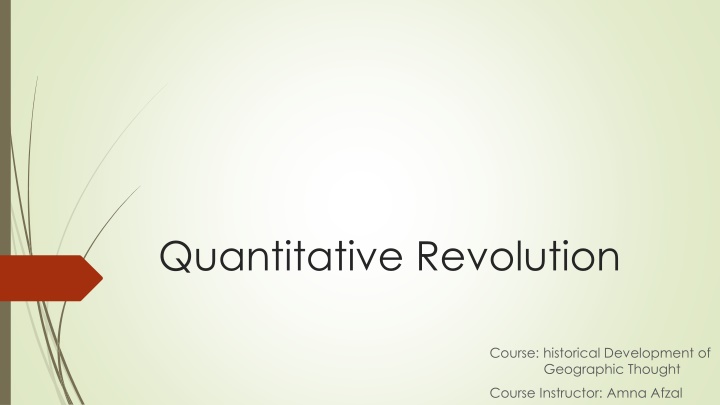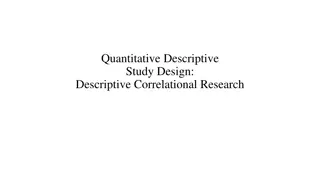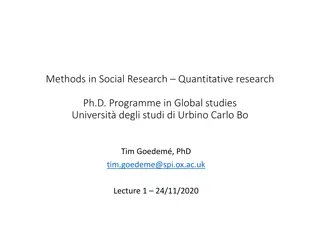Evolution of Geographic Thought: Quantitative Revolution
The Quantitative Revolution in Geography, led by Schaefer's critique of traditional views, propelled the shift towards a more objective and scientific approach. Embracing statistical and mathematical techniques, geographers sought regularities in spatial organization, marking a transition from areal to spatial perspectives. Influential figures such as Haggett and Harvey further advanced the field, shaping a new era characterized by Newtonian physics and neoclassical economics principles.
Download Presentation

Please find below an Image/Link to download the presentation.
The content on the website is provided AS IS for your information and personal use only. It may not be sold, licensed, or shared on other websites without obtaining consent from the author.If you encounter any issues during the download, it is possible that the publisher has removed the file from their server.
You are allowed to download the files provided on this website for personal or commercial use, subject to the condition that they are used lawfully. All files are the property of their respective owners.
The content on the website is provided AS IS for your information and personal use only. It may not be sold, licensed, or shared on other websites without obtaining consent from the author.
E N D
Presentation Transcript
Quantitative Revolution Course: historical Development of Geographic Thought Course Instructor: Amna Afzal
Quantitative Revolution Quantitative revolution or the view of geography as a study of spatial organization started with the publication of Exceptionalism in geography: A method- by Schaefer. F (1953) in Annals of the Association of American Geographers Schaefer criticized the chorological Hartshorne and claimed that the view that geography is an integrative science concerned with the unique was naive and arrogant because such issues ere common to many sciences (Aerial Differentiation) viewpoints of
Cont. By refusing to search for explanatory laws, geography condemned itself to what Schaefer called an immature science Rather than seeking idiographic regions, geographers should seek nomothetic regularities across regions. This critique helped open the door to the rise of positivism and the quantitative revolution
Cont Use of the abstract model using the statistical and mathematical technique in geography to make the subject more objective is collectively known as Quantitative Revolution in geography After the 1950s, particularly after the Schaefer-Hartshorne debate, geography was considered as a study of spatial organization or spatial interaction
Cont The hitherto dominant theme of geography, areal differentiation has been abandoned by number of geographers and there was a shift from areal to spatial, absolute space to relative space as well as from areal integration to spatial interaction. Therefore Schaefer with his spatial organization paradigm, initiated what may be called the quantitative or theoretical revolution in geography. According to Schaefer, geography should be conceived as a science concerned with the formulation of laws governing the spatial distribution of certain features on the surface of the earth.
Cont During methodological and philosophical basis of the quantitative school or spatial science school were made mostly through the works of renowned Anglo American geographers like P, Haggett, R.J. Chorley, W. Bunge and David Harvey 1960s the major advances towards a unifying
Cont The new geography that emerged and was solidified by the mid 1960s, was characterized by several features 1. Newtonian physics provided ideas of gravity and potential as well as the basis for spatial interaction modeling, that is, the analysis of geographic flows of people and things. 2. neoclassical economics gave the rationality postulate used to theorize geographic choice. 3. German school of location theory offered mathematically exact models of agricultural land use, industrial location, and urban economic settlement patterns. 4. Urban sociology afforded both intra- and inter-metropolitan explanatory models of population and their sociological characteristics. 5. Geometry made available axioms of topology (the mathematical study of spatial forms) used in transportation studies.
Cont The use of an increasingly sophisticated set of statistical and mathematical methods. 1. A reliance on computerization. 2. A new professional and social structure. 3. The emergence of an alternative philosophical justification for geographic research positivism. David Harvey s explanation in geography, published in 1969, was the culminating volume arguing that legitimating the quantitative revolution was logical positivism, a philosophy averring that true statement were those in which logically consistent theory corresponded flawlessly to experientially grounded facts.
Cont The main objectives of the quantitative revolution in geography as under: 1. To change the descriptive character of the subject and to make it a scientific discipline 2. To explain and interpret the spatial patterns of geographical phenomena in a rational, objective and cogent manner 3. To use mathematical language instead of the language of literature 4. To make precise statements (generalizations) about locational order 5. To test hypothesis and formulate models, theories and laws for estimations and predictions 6. To identify the ideal locations for the various economic activities so that the profit may be maximized by the resource users 7. To provide geography a sound philosophical methodology objective ad scientific and theoretical base, and to make its
Cont Structuralist geographers many of them Marxists recognized that some socio-spatial relationships and observed conditions were the result of the production process. Humanism sought to reposition humans and their experiences at the center of the discipline in an attempt to unpack the meaning of space, place, and region. Behavioralism was an attempt to insert people into existing models by abandoning rational economizing principles of human behavior and inserting the concept of bounded rationality and the satisficer.
Cont During resurgence. The primary motivation for the resurgence was the expansion of geotechnical applications, such as the 1990s, quantitative geography experienced a I. Geographic information systems (GIS), II. Global Positioning System (GPS), III. Remote Sensing, IV. Growing dominance of Geotechniques.























